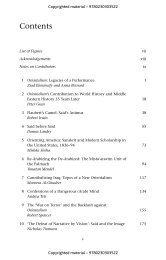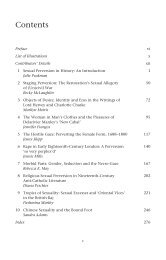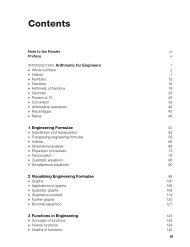Download sample chapter - Palgrave
Download sample chapter - Palgrave
Download sample chapter - Palgrave
You also want an ePaper? Increase the reach of your titles
YUMPU automatically turns print PDFs into web optimized ePapers that Google loves.
Copyrighted material – 9781137343512<br />
2 / florence vatan and marc silberman<br />
individual initiatives: official commemorations, trials for war crimes or<br />
crimes against humanity, monuments, museums, on-site memorials, literary,<br />
photographic and cinematic representations, exhibitions, art installations,<br />
and artistic performances.<br />
These various case studies demonstrate how memory cultures evolve<br />
over time and how they handle the competing demands between a nostalgic<br />
turn toward the past and a utopian impulse geared toward the future.<br />
They also testify to the forces of globalization and cosmopolitization,<br />
while pointing to the importance of remaining attuned to the specificity<br />
of geopolitical and local contexts. 2 If recurrent trends in commemorative<br />
practices and common tropes in the display and staging of past violence<br />
create a global “rhetoric” of memorialization, each particular memoryscape<br />
brings its own specific set of challenges. For the commemoration of<br />
the past remains a controversial and contested field whose dynamics are<br />
fueled by competing memory paradigms, different and sometimes mutually<br />
exclusive groups of victims, shifting present-day stakes, and divergent<br />
representations of the future. Dissonances and dissident voices as well as<br />
forms of “reactive” and “multidirectional” memory unsettle the hegemony<br />
of master narratives and bring to the fore tensions and points of friction. 3<br />
These dissonances reflect a fractured past and a divided present. They also<br />
result from the democratization of memory and the pluralization of its<br />
modes of production and channels of diffusion.<br />
The commemoration of a difficult past raises challenges related to historical,<br />
political, and sociocultural contexts. It also raises challenges inherent<br />
to the process of memory making. Unlike heroic struggles, military<br />
triumphs, and revolutionary victories—privileged hallmarks of national<br />
celebrations and grandiose commemorations—traumatic or infamous<br />
pasts do not lend themselves to smooth or self-aggrandizing narratives.<br />
Nations are reluctant to exhume a past that is perceived as divisive and detrimental<br />
to their official self-image or national mythology. In the postwar<br />
years, France’s myth of the Résistance prevented a critical engagement with<br />
Vichy France’s collaboration with Nazi Germany. During the Cold War<br />
memorials in concentration camps located in Eastern Europe celebrated<br />
the heroic socialist and Soviet struggle against fascism, thus downplaying<br />
the plight of Holocaust victims. In democratic Spain a seemingly collective<br />
decision to protect the postfascist transition led to a “model of impunity”<br />
that prevented direct confrontation with Francoist repression. Similarly<br />
in the wake of the call for national reconciliation memorials in postapartheid<br />
Africa have toned down past racial divides in the name of a new,<br />
projected multicultural and multiethnic country. Acknowledging histories<br />
of violence and trauma, while also seeking reconciliation and inclusivity,<br />
remains a daunting task. The desire to forget is not specific to governing<br />
Copyrighted material – 9781137343512
















